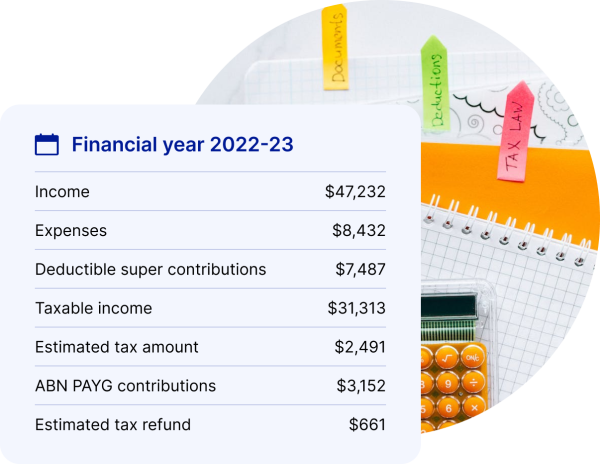
Calculating your taxable income
Key takeaways:
Learn what does and doesn’t count as taxable income
Use a calculator to estimate your taxable income
Find out what to do with multiple sources of income
Figure out your tax rate for this year and next year
To file your taxes, you need to understand your taxable income – the money you earned this past financial year that is eligible to be taxed by the ATO.
This is the income you earned from full-time, part-time, or casual employment, minus any business expenses.
To avoid a big tax bill at the end of the year, you’ll need to estimate your income every quarter. This allows you to make payments to the ATO, reducing your tax bill so that EOFY doesn’t come as a surprise.
How do I figure out my taxable income as a sole trader?
For the first year after you register for an ABN, you’ll need to estimate your own taxes.
After you’ve lodged your first income tax return, the ATO will begin sending you estimates of how much they expect you’ll earn.
Remember: the ATO’s estimate isn’t always accurate, so it’s best to do you own estimates as well.
Sole trader tax rate for 2024-2025
The table below shows you the different tax thresholds for Australian taxpayers. You’ll fall into one of the brackets on the left, and the right-hand column shows you how much you can expect to be taxed.
Taxable income | Tax on this income |
|---|---|
0 – $18,200 | Nil |
$18,201 – $45,000 | 16c for each $1 over $18,200 |
$45,001 – $135,000 | $4,288 plus 32.5c for each $1 over $45,000 |
$135,001 – $190,000 | $31,288 plus 37c for each $1 over $135,000 |
$190,001 and over | $51,638 plus 45c for each $1 over $190,000 |
This does NOT include the Medicare levy, so make sure to add an extra 2% of your total taxable income to your calculations.
Pro-Tip: Rounded’s calculator automatically applies the relevant tax rate based on your taxable income and factors in your Medicare levy and any PAYG contributions you’ve made.
This means you can see how much tax you’re likely to owe (or get back) at any point throughout the year and can easily plan ahead.
How does the ATO estimate your income?
For your first year, the ATO will not require you to register for PAYG instalments, so it’s up to you to be proactive and set aside money for taxes on your own. You can also voluntarily register to make PAYG instalments during your first year.
After your most recent income tax return lodgement, the ATO may automatically register you for PAYG instalment payments, depending on if you had an amount of income tax payable, and also taking into consideration the amount of your taxable income reported.
The ATO will use your reported income from your most recent income tax return to estimate your taxable income and related PAYG-I for the following year.
What if my situation changed?
The ATO will use your reported income from your most recent income tax return to estimate your taxable income and related PAYG-I for the following year.
How do I make my own estimates?
For Rounded Users...
Your Rounded dashboard helps you monitor exactly how much money you have coming in and how much you’re spending on business expenses. With custom reporting, you can pull all the figures you need to make an accurate estimate of your taxable income.
Login to my accountFor Non-Rounded Users...
Use your invoices, bank statements, and receipts to determine how much you’ve made over the last few quarters. You can use these figures to estimate how much you’ll likely owe in the coming quarter. Sound like a headache? Start your Rounded free trial now.
Start my free trial
What if I have multiple sources of income as a sole trader?
It’s very common for freelancers and sole traders to hold a part-time or even full-time job during a single financial year.
For example, you may leave your full-time job partway through the year and begin freelancing full-time. Or you might have a part-time job at a business, and run your own freelance business on the side.
In either scenario, the company that employs you will manage quarterly tax payments on your behalf, while you’ll pay tax on income earned for your freelance business.
You’ll report both sources of income to the ATO on your annual tax return, but your quarterly PAYG instalments are only for your freelance income.
When in doubt, overestimate
If you’re struggling to estimate your own taxes, it’s always best to overestimate how much you owe. This way, you’ll be more likely to get money back at the end of the year, rather than owe money to the ATO.
Try estimating your taxes using your gross income: everything you earned, without deducting any business expenses. This will give you a conservative estimate, which means you’ll be less likely to owe money at the end of the year (and more likely to get some money back).
Get automatic estimates
Let us take care of the calculations for you. Get real-time estimates of how much tax you’ll owe and never worry about surprise tax bills again.

-
 Step One
Step OneSole Trader Tax: Glossary and Dates
Essential information you need before you start -
 Step 2
Step 2Calculating your taxable income
Track how much tax you’ll owe and plan ahead -
 Step 3
Step 3What can I claim on tax as a sole trader?
How to use business expenses to cut down on your tax bill -
 Step 4
Step 4Sole trader GST
Learn how to collect and pay GST -
 Step 5
Step 5BAS & PAYG for sole traders
Pay taxes throughout the year to make EOFY easier -
 Step 6
Step 6Checklist for filing your sole trader tax return